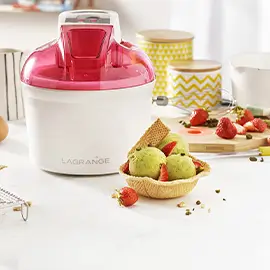Manufacturing, Materials and Durability
Discover the high-quality materials used in our Lagrange products and our commitment to sustainability. Learn how we design durable and environmentally friendly products.
What does the warranty cover?
The Lagrange warranty covers manufacturing or product conformity defects for a legal period of 2 years from the date of purchase, in accordance with current legislation. It only applies if the appliance has been used according to the provided instructions. The warranty does not cover damage due to misuse, improper maintenance, normal wear and tear, or consumable parts. You can consult the detailed conditions on the official page: Lagrange Terms and Conditions of Sale.
See more
See less
Is it normal for my heating element holder to oxidize (rust marks)?
Oxidation marks may appear on the heating element holder due to moisture. This phenomenon does not affect the functionality of the appliance and can be cleaned using a soft cloth.
See more
See less
Where can I store my appliances?
We advise against storing your appliances in cold and humid conditions. Avoid storing them in a garage or cellar.
See more
See less
What should I do if my appliance malfunctions?
In case of malfunction, contact our after-sales service via our chatbot or contact form for assistance.
See more
See less
Where can I dispose of my appliance when it's at the end of its life or irreparable?
You can drop off your appliance at a collection point dedicated to Waste Electrical and Electronic Equipment (WEEE).
See more
See less
Are you committed to an eco-responsible approach?
Yes, we work to extend the lifespan of our products, promote repairability, limit waste and improve the traceability of our materials. We work with French or European partners and favor sustainable materials whenever possible. Discover our commitments here.
See more
See less
What are your commitments?
At Lagrange, we place sustainability, repairability, and safety at the heart of our approach. We design robust products built to last, and offer an after-sales service with spare parts available for many years after purchase. We also promote short and responsible supply chains to limit our environmental impact. Our commitments here.
See more
See less
How to maintain appliances with stainless steel surfaces?
Use a soft, damp cloth with a little white vinegar or a special stainless steel cleaner. Then dry with a clean cloth to avoid marks.
See more
See less
Why isn't my plate heating evenly?
Check that the plate is properly positioned and correctly plugged in. If the problem persists, contact our customer service.
See more
See less
How is the non-stick coating applied to Lagrange products?
Lagrange rigorously selects its coating suppliers and ensures their application according to current industrial standards, guaranteeing their effectiveness and safety. For more details on the application processes, we invite you to visit our dedicated page.
See more
See less
What is the non-stick coating of Lagrange appliances made of?
We use different types of non-stick coatings depending on the appliances and their uses:
PTFE (Polytetrafluoroethylene): extremely slippery and chemically inert, it ensures non-stick cooking. It is safe for human health, even if accidentally ingested, and contains only long-chain PFAS (non-bioaccumulative).
Silicone: flexible, easy to clean and ideal for baking molds.
Ceramic: a PTFE-free alternative, it better resists high temperatures but can be more fragile.
All our coatings comply with European regulations and are safe to use under normal conditions. We recommend not exceeding 260°C to preserve the coating's durability and avoid any potential emissions at high temperatures.
You can find all the information here.
See more
See less
Is the non-stick coating safe?
Yes. All non-stick coatings used by Lagrange comply with European regulations. PTFE, in particular, is chemically inert and safe for health, even if accidentally ingested. It only contains long-chain PFAS, which are considered non-bioaccumulative.
You can find all the information here.
See more
See less
What are PFAS?
PFAS are a broad family of chemical substances. Those present in the PTFE used by Lagrange are long-chain fluoropolymers, which are non-bioaccumulative and inert. Their use is authorized because they do not react with the human body or the environment.
You can find all the information here.
See more
See less
What is the thickness of the Plancha Pro plate?
The plate of the Plancha Pro is made of stainless steel and has a thickness of 3 millimeters.
See more
See less
What is the diameter of the Crêpière Pro plate?
The Crêpière Pro plate measures 40cm in diameter and is made of enameled cast aluminum, perfect for making large, delicious crepes!
See more
See less

